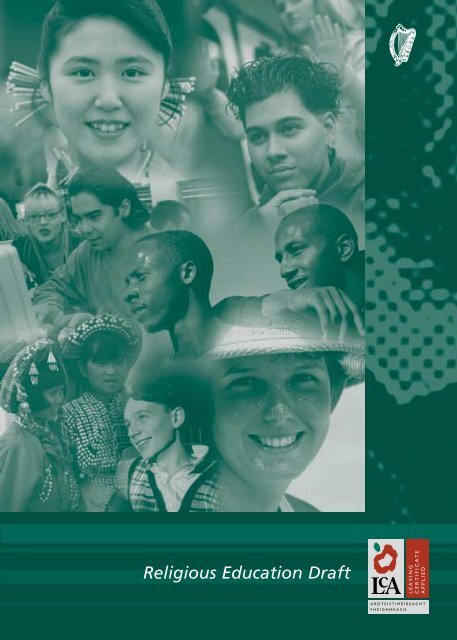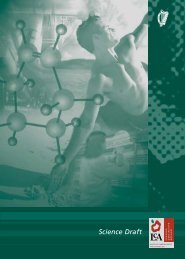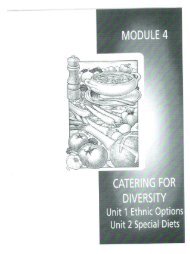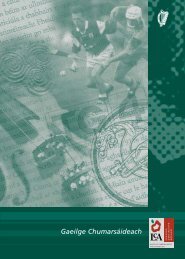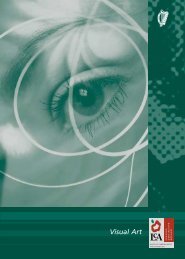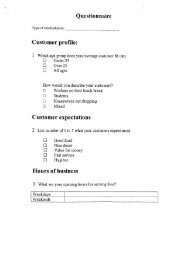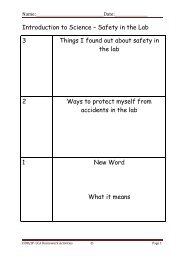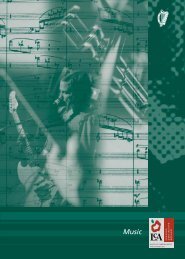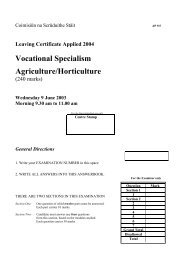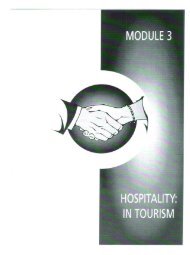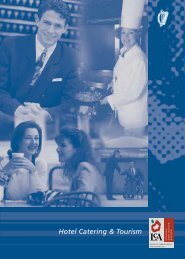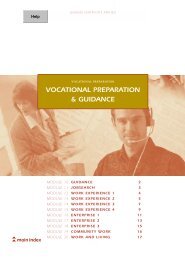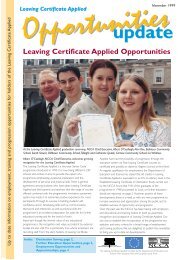Religious Education Draft - PDST
Religious Education Draft - PDST
Religious Education Draft - PDST
Create successful ePaper yourself
Turn your PDF publications into a flip-book with our unique Google optimized e-Paper software.
<strong>Religious</strong> <strong>Education</strong> <strong>Draft</strong>
TOPICS IN COMMON<br />
RELIGIOUS<br />
EDUCATION<br />
Agencies<br />
Contemporary Issues<br />
Cultural Diversity<br />
Environment<br />
Equality<br />
Gender<br />
Health<br />
Human Rights<br />
Lifestyle<br />
Local Community<br />
Media<br />
Older People<br />
Special Needs<br />
Worker Rights &<br />
Responsibilities<br />
COURSE<br />
Vocational Preparation & Guidance<br />
English & Communications<br />
Mathematical Applications<br />
Social <strong>Education</strong><br />
Active Leisure Studies<br />
Agriculture/Horticulture<br />
Childcare/Community Care<br />
Graphics & Construction Studies<br />
Craft & Design<br />
Engineering<br />
Hair & Beauty<br />
Hotel Catering & Tourism<br />
Information & Communication Technology<br />
Office Administration & Customer Care<br />
Technology<br />
Gaeilge<br />
Arts - Visual-Drama-Music & Dance<br />
Introduction to Information & Communication Technology<br />
Leisure & Recreation<br />
Modern Language<br />
Science<br />
Sign Language
LEAVING CERTIFICATE APPLIED<br />
GENERAL EDUCATION<br />
RELIGIOUS EDUCATION<br />
DRAFT
RELIGIOUS EDUCATION
RELIGIOUS EDUCATION<br />
CONTENTS<br />
INTRODUCTION 3<br />
Rationale 3<br />
Number and Sequence of Modules 4<br />
Description of Modules 4<br />
General Recommendations 5<br />
MODULE 1<br />
LOOKING IN 7<br />
Purpose 8<br />
Prerequisites 8<br />
Aims 9<br />
Units 9<br />
Unit 1: Religion 10<br />
Unit 2: Belief 12<br />
Unit 3: Images of God 14<br />
Unit 4: Prayer 16<br />
Unit 5: Ritual 18<br />
Unit 6: Liturgical Celebration 20<br />
Resources 21<br />
Key Assignments 24<br />
MODULE 2<br />
OUR RELIGIOUS STORY 25<br />
Purpose 26<br />
Prerequisites 26<br />
Aims 27<br />
Units 27<br />
Unit 1: Religion and Story 28<br />
Unit 2: <strong>Religious</strong> Communities, Inter-Faith Dialogue<br />
and Ecumenism 30<br />
Unit 3: Religion and the Local Community 31<br />
Unit 4: Faith in Action 32<br />
Unit 5: The Story of Living Faith 33<br />
Option 1: Older People 33<br />
Option 2: Disability 35<br />
Option 3: Working with the Homeless 36<br />
Unit 6: Religion and the Media 37<br />
Resources 38<br />
Key Assignments 43<br />
1
RELIGIOUS EDUCATION<br />
MODULE 3<br />
A LIVING FAITH 45<br />
Purpose 46<br />
Prerequisites 46<br />
Aims 46<br />
The Themes 47<br />
Resources 51<br />
Key Assignments 56<br />
MODULE 4<br />
WORLD RELIGIONS 57<br />
Purpose 58<br />
Prerequisites 58<br />
Aims 59<br />
Units 59<br />
Units 1-5: Buddhism 61<br />
Christianity<br />
Hinduism<br />
Islam<br />
Judaism<br />
Unit 6: New <strong>Religious</strong> Movements 65<br />
Resources 66<br />
Key Assignments 68<br />
2
RELIGIOUS EDUCATION<br />
I NTRODUCTION<br />
RATIONALE<br />
This religious education syllabus seeks to support the holistic aims of<br />
education by promoting personal growth and facilitating spiritual<br />
development. It engages the students in the human search for<br />
meaning and offers them an opportunity to reflect, understand<br />
and interpret that experience in the light of our changing world.<br />
It invites students to examine religious stories, and where appropriate,<br />
their own religious story, and to value their place within it now and in<br />
the future. It exposes them to a broad range of religious traditions and<br />
encourages the promotion of mutual understanding and tolerance.<br />
It facilitates moral development through the application of a process<br />
of moral decision-making.<br />
3
RELIGIOUS EDUCATION<br />
NUMBER AND SEQUENCE OF MODULES<br />
One, two, three or all four of these modules may be taken as elective<br />
modules. Module one “Looking In” is core to the course and must be<br />
taken first. After module one the remaining modules may be covered<br />
in any order.<br />
Module 1<br />
Module 2<br />
Module 3<br />
Module 4<br />
Looking In<br />
Our <strong>Religious</strong> Story<br />
A Living Faith<br />
World Religions<br />
DESCRIPTION OF MODULES<br />
Module 1 Looking In<br />
This module presents students with the opportunity to reflect on their<br />
present position in relation to issues of religion, faith, prayer and ritual.<br />
It also encourages participation in liturgical celebrations.<br />
Module 2 Our <strong>Religious</strong> Story<br />
This module encourages students to explore religious stories. It asks<br />
them to become aware of the power of stories to portray deeper truths<br />
about the human condition and the spiritual search for meaning.<br />
The module tracks the link between tradition and present day faith<br />
in action, while providing students with an opportunity for active<br />
participation in, or observation of, their own communities.<br />
4
RELIGIOUS EDUCATION<br />
Module 3 A Living Faith<br />
This module follows a thematic approach. It focuses on sets of moral<br />
issues and asks students to explore religious teachings in relation to<br />
them. The views and values of the students are juxtaposed with the<br />
moral visions of two religious traditions on the issue. Students will be<br />
asked to explore moral dilemmas and observe or participate in a<br />
religious service relevant to the issue under examination.<br />
Module 4 World Religions<br />
This module promotes an in-depth exploration of world religions.<br />
It focuses on common features while drawing attention to the unique<br />
characteristics of the tradition under consideration. The value of<br />
diversity in religious traditions is stressed.<br />
GENERAL RECOMMENDATIONS<br />
The Teacher Guidelines in this syllabus are intended as suggestions.<br />
Teachers ought to take account of the needs and interests of the group.<br />
The emphasis, as in all of Leaving Certificate Applied courses, is on the<br />
process. Practical activity-based methodologies are most appropriate.<br />
It is recommended that students complete a Religion journal as they<br />
progress through the modules. The fourth key assignment in each<br />
module facilitates this.<br />
5
RELIGIOUS EDUCATION<br />
6
RELIGIOUS EDUCATION<br />
MODULE 1<br />
LOOKING IN<br />
7
RELIGIOUS EDUCATION • LOOKING IN<br />
MODULE 1:<br />
LOOKING IN<br />
PURPOSE<br />
This module presents students with the opportunity to reflect<br />
on their present position in relation to issues of religion,<br />
faith, prayer and ritual. It also encourages participation in<br />
liturgical celebrations.<br />
PREREQUISITES<br />
None.<br />
8
RELIGIOUS EDUCATION • LOOKING IN<br />
AIMS<br />
This module aims to:<br />
• enable students to explore the place of religion in their lives<br />
• encourage students to examine how images of God influence faith<br />
• facilitate investigation of different forms of prayer and ritual<br />
• provide opportunities for participation in and/or observation<br />
of liturgical celebrations.<br />
UNITS<br />
Unit 1<br />
Unit 2<br />
Unit 3<br />
Unit 4<br />
Unit 5<br />
Unit 6<br />
Religion<br />
Belief<br />
Images of God<br />
Prayer<br />
Ritual<br />
Liturgical Celebration<br />
9
RELIGIOUS EDUCATION • LOOKING IN • RELIGION<br />
Unit 1: Religion<br />
LEARNING OUTCOMES<br />
TEACHER GUIDELINES<br />
The students will be able to:<br />
1. define what is meant by "religion"<br />
2. outline the beliefs and practices<br />
of people in Ireland today<br />
3. compare and contrast the results<br />
of an investigation<br />
4. state their own position in relation<br />
to the results of an investigation.<br />
Undertake a class investigation<br />
"What is religion?" Students interview<br />
their friends, family and neighbours.<br />
They should select a variety on the<br />
basis of age, sex, belief and culture.<br />
Possible questions could include:<br />
How would you describe religion?<br />
Is religion important to you?<br />
Why/why not?<br />
How does religion give meaning<br />
to your life on a day to day basis?<br />
Have there been any particular times<br />
in your life when religion played an<br />
important part? If so, when and why?<br />
Does religion make any demand on<br />
your life in terms of behaviour,<br />
thought and action?<br />
Do you belong to a particular church?<br />
How would you rate your attendance<br />
and involvement in your church?<br />
The results of the investigation should<br />
be collated and presented as a<br />
wall chart.<br />
Students should be able to draw up a<br />
profile of:<br />
(a) religious experience<br />
(b)religious practice in the community.<br />
10
RELIGIOUS EDUCATION • LOOKING IN • RELIGION<br />
Unit 1: Religion (Continued)<br />
LEARNING OUTCOMES<br />
TEACHER GUIDELINES<br />
The following questions may help<br />
to analyse the survey: What have<br />
we discovered about religion?<br />
What have we discovered about<br />
the practices and attitudes of people<br />
with regard to religion?<br />
How are important moments in life<br />
celebrated? How are these moments<br />
celebrated in different religions?<br />
Differences/similarities among<br />
old/young people.<br />
What parts can they most/least<br />
identify with?<br />
Students should be encouraged to<br />
reflect on "where do I stand in<br />
relation to this?"<br />
11
RELIGIOUS EDUCATION • LOOKING IN • BELIEF<br />
Unit 2: Belief<br />
LEARNING OUTCOMES<br />
TEACHER GUIDELINES<br />
The student will be able to:<br />
1. identify key features of adolescent faith<br />
After completing the class investigation,<br />
on "What is religion?" students should<br />
answer in writing the question<br />
"What do I believe?" – Perhaps holding<br />
an interview with the imaginary<br />
interviewee who knows nothing<br />
at all about religious belief would<br />
help students to do this exercise.<br />
Using large sheets of paper, students<br />
work in groups, and try to list as<br />
many positive "I believe….."<br />
statements as possible.<br />
Teachers should look at this list critically<br />
and stress faith statements. The teacher<br />
should then assist the students in<br />
drawing up a "Young Person’s Creed".<br />
Compare this creed with those found<br />
in major religions.<br />
2. participate in or observe a prayer<br />
service using the class creed<br />
3. compare and contrast childhood faith<br />
with adolescent faith<br />
If appropriate use the class creed in<br />
a school liturgical activity.<br />
Each student could create their own<br />
faith profile (similar to lifeline). Students<br />
could put together a profile of their<br />
religious background to identify how<br />
their faith has been shaped up to the<br />
present time.<br />
Facilitate a class discussion on the factors<br />
that influence their religious belief and<br />
practice as an adolescent.<br />
12
RELIGIOUS EDUCATION • LOOKING IN • BELIEF<br />
Unit 2: Belief (Continued)<br />
LEARNING OUTCOMES<br />
TEACHER GUIDELINES<br />
Through discussion , explore the move<br />
from the "cultural" faith of the child to<br />
the "convictional" faith of the teenager.<br />
This exercise gives students an<br />
opportunity to tell their own story.<br />
4. list the stages of faith development<br />
5. articulate their present faith position.<br />
Present the idea of faith development<br />
e.g. Fowler’s Faith Stages.<br />
<br />
Discuss this as a class and then each<br />
student writes their own evaluation,<br />
using their faith line.<br />
Students attempt to answer the<br />
question: "Where do I see myself<br />
right now?"<br />
13
RELIGIOUS EDUCATION • LOOKING IN • IMAGES OF GOD<br />
Unit 3: Images of God<br />
LEARNING OUTCOMES<br />
TEACHER GUIDELINES<br />
The student will be able to:<br />
1. identify their present image of<br />
God and compare it with possible<br />
childhood images<br />
Students can be given time to draw<br />
or write "My image of God " –<br />
they could revisit their Faith Line and<br />
identify images they had as children.<br />
2. compare and contrast the images of<br />
God found in ancient religions,<br />
world religions and modern culture<br />
Examine the images of God found in<br />
(a) Ancient religions.<br />
(b)World religions, exploration of the<br />
images of God found in Christianity,<br />
Islam, Buddhism, Hinduism, and<br />
Judaism. This can be done through<br />
group project work.<br />
(c) The modern world. This can be<br />
achieved through the use of video,<br />
newspapers, film, exploration of<br />
their own experience, Sacred Text,<br />
stories, interviews with<br />
adults/teenagers/children.<br />
3. discuss the effects of these images<br />
on growth in faith<br />
Prepare a collage of all the different<br />
images (in groups or as a class).<br />
Examine the images and how they affect<br />
growth in faith.<br />
4. say which image they are most<br />
comfortable with and why<br />
or<br />
5. give reasons why they have no<br />
image of God<br />
Students should now select an image<br />
of God which has particular appeal<br />
for them. They should be able to<br />
justify their choice.<br />
14
RELIGIOUS EDUCATION • LOOKING IN • IMAGES OF GOD<br />
Unit 3: Images of God (Continued)<br />
LEARNING OUTCOMES<br />
TEACHER GUIDELINES<br />
6. list secular/non religious answers<br />
to the meaning of life<br />
7. list occasions when young people may<br />
feel particularly close to God<br />
8. outline the views of two major religious<br />
traditions on suffering and evil<br />
The teacher presents material<br />
for discussion and group work –<br />
illustrating a variety of world views<br />
in contemporary culture – e.g. holiday<br />
programmes for hedonism etc.<br />
Brainstorm times people feel<br />
close to God.<br />
In groups look at our world today and<br />
draw up a list of questions needing<br />
answers e.g. famine in Africa, ethnic<br />
cleansing, a Down’s Syndrome child.<br />
Search newspapers for articles,<br />
photographs, watch the news.<br />
The Photospeak photo images<br />
resource pack could be used here.<br />
Report to class.<br />
Facilitate a discussion on why bad<br />
things happen to good people.<br />
Present a summary of perspectives<br />
on suffering and evil in two<br />
religious traditions.<br />
9. identify signs of hope in our<br />
world today.<br />
Examine the media for signs of hope<br />
in our world. Focus on people of hope<br />
in pop culture.<br />
Compare and contrast images of<br />
suffering and evil with images of hope.<br />
15
RELIGIOUS EDUCATION • LOOKING IN • PRAYER<br />
Unit 4: Prayer<br />
LEARNING OUTCOMES<br />
TEACHER GUIDELINES<br />
The student will be able to:<br />
1. discuss why, how, when and<br />
where people pray<br />
Students should conduct a prayer survey<br />
among their peers, family and in the<br />
locality. As a class they should try to<br />
answer the following:<br />
Why do people pray? To be<br />
close to God in times of need,<br />
sadness, happiness.<br />
When do people pray? Times of prayer,<br />
morning, evening, Sundays, death,<br />
sacred times e.g. Christmas, Easter,<br />
Lent, Ramadan, Diwali etc.<br />
What do people pray? Traditional set<br />
prayers, praying through Sacred Text,<br />
prayer of the Church, song, spontaneous<br />
prayer, Eucharist, meditation, mantras<br />
etc. Collect examples of each.<br />
Where do people pray? Synagogue,<br />
Mosque, Church, Shrines and Holy<br />
places etc. Visit some of these<br />
where possible.<br />
How do people pray? The use of symbol,<br />
words, song, dance, contemplation,<br />
communal, personal, guided etc.<br />
Practise some of these.<br />
16
RELIGIOUS EDUCATION • LOOKING IN • PRAYER<br />
Unit 4: Prayer (Continued)<br />
LEARNING OUTCOMES<br />
TEACHER GUIDELINES<br />
Students should put together a prayer<br />
book containing children’s prayers,<br />
prayers for exam time, the elderly, a<br />
mother’s prayer, favourite prayers from<br />
Sacred text, their own prayers etc.<br />
2. participate in or observe different forms<br />
of prayer and give an account of their<br />
observations.<br />
Students should visit local places of<br />
worship and write a report on the<br />
similarities and differences noted.<br />
Explore the symbols used for prayer in<br />
their own and in other religious<br />
traditions; water, crosses, candles,<br />
incense, musical instruments etc.<br />
Compile a pictorial representation of<br />
words, symbols, ideas drawn from their<br />
own religion.<br />
Invite visitors from different religious<br />
traditions into the classroom to<br />
demonstrate or discuss various prayer<br />
forms with the students.<br />
Hold a prayer service using their prayer<br />
book and some of the prayer forms they<br />
have studied.<br />
Practise using different types of prayer,<br />
vocal, meditation, and contemplation.<br />
Communal prayer/personal prayer.<br />
It would be very important here that<br />
students get a chance to participate in<br />
different forms/types of prayer.<br />
Students should be offered the<br />
opportunity of going on retreat.<br />
17
RELIGIOUS EDUCATION • LOOKING IN • RITUAL<br />
Unit 5: Ritual<br />
LEARNING OUTCOMES<br />
TEACHER GUIDELINES<br />
The student will be able to:<br />
1. explain and contrast types of ritual<br />
and discuss their meaning<br />
2. distinguish between religious<br />
and secular ritual<br />
Present ritual, identify areas of<br />
ritual, going to a disco – what do<br />
we do? – preparing for graduation –<br />
what is the procedure? – marriage<br />
preparations – what are they?<br />
Are they similar for most people?<br />
Encourage students to chart ritual<br />
in their lives.<br />
Discuss why we have ritual – security,<br />
continuity with tradition, habit.<br />
Research ritual in Irish society –<br />
buildings, sites. Why are these<br />
important? – meaning of ritual.<br />
3. describe ritual in religion<br />
4. give examples of the significance of<br />
religious ritual for believers.<br />
Brainstorm occasions /examples of<br />
ritual in religion.<br />
Present ritual in religious community<br />
as an expression of faith. Brainstorm<br />
different forms of worship – attend<br />
liturgy – analyse ritual in liturgy – invite<br />
lay ministers and youth ministers to<br />
discuss their involvement in ritual.<br />
Present sacraments (or celebrations of<br />
significant moments in two major world<br />
religions) and explore/discuss/compare<br />
the symbol, ritual, meaning and<br />
significance of the celebration for the<br />
community of believers.<br />
18
RELIGIOUS EDUCATION • LOOKING IN • RITUAL<br />
Unit 5: Ritual (Continued)<br />
LEARNING OUTCOMES<br />
TEACHER GUIDELINES<br />
Pair work – students research a<br />
sacrament or similar celebration under<br />
headings of symbol, ritual, significance,<br />
community involvement, meaning –<br />
present report to group – possibility for<br />
use of home video of Baptism,<br />
Confirmation ceremonies here.<br />
Students prepare Liturgy/Prayer service<br />
on the themes of ritual and symbol in<br />
sacramental celebration.<br />
19
RELIGIOUS EDUCATION • LOOKING IN • LITURGICAL CELEBRATION<br />
Unit 6: Liturgical Celebration<br />
LEARNING OUTCOMES<br />
TEACHER GUIDELINES<br />
The student will be able to:<br />
1. participate in or observe different<br />
types of liturgical celebration.<br />
It is suggested that this unit presents the<br />
students with two or three meaningful<br />
liturgical experiences as examples of<br />
religious communities celebrating.<br />
SHOULD THE TEACHER CHOOSE NOT<br />
TO DO THIS THERE IS AN OPTION TO<br />
INCLUDE ONE OF THE ABOVE (OR<br />
OTHER CELEBRATIONS) IN EACH OF<br />
THE FIVE PRECEDING UNITS.<br />
Some examples of liturgies are:<br />
Musical Meditation, Silent Reflection,<br />
Liturgical dance, Scripture Drama,<br />
Service of Light, Penitential Service,<br />
Eucharistic Celebration.<br />
The choice of liturgy could be informed<br />
by the liturgical/sacred calendar of<br />
religious traditions.<br />
A group of 10 students is an optimum<br />
group for spiritual reflection –<br />
investigate the possibility of dividing<br />
a large group for liturgies.<br />
Students record their most meaningful<br />
experiences in their reflective journal.<br />
20
RELIGIOUS EDUCATION • LOOKING IN<br />
RESOURCES<br />
SUGGESTED RESOURCES - UNIT 1 RELIGION<br />
BOOKS<br />
New Zealand Series, (70 books published in 1991 by National<br />
Centre for <strong>Religious</strong> Studies, 30 New Street, Auckland, New Zealand<br />
(- available - Resource Centre Mater Dei Institute, Dublin.)<br />
Understanding the Catechism Series, Resources for Christian Living,<br />
Workbooks and Teacher Guides. (Available from Cathedral Books).<br />
Reason to Believe by A. Walsh Veritas 1994.(p. 41 - Why people<br />
believe, p.88 growth of faith).<br />
SUGGESTED RESOURCES - UNIT 2 BELIEF<br />
BOOKS:<br />
The Road to Emmaus Programme - Catholic Youth Council - personal<br />
life stories and reflections on faith.<br />
Living Faith, The Christian Experience by Keene M. Stanley Thornes<br />
Publications 1995.<br />
Beliefs, Values and Traditions by A. Lovelace. & J. White<br />
Heinemann <strong>Education</strong>al<br />
Celtic Way of Life, CDU Publications, O’Brien, 1976<br />
Reason to Believe by A. Walsh, Veritas Publications 1994<br />
SUGGESTED RESOURCES - UNIT 3 IMAGES OF GOD<br />
BOOKS:<br />
Dimensions of Christianity, - An approach to GCSE <strong>Religious</strong> Studies<br />
by Sr. Anne Burke, Mayhew Publications, UK 1988.<br />
Faith Development Booklet by Brother Martin O’ Flaherty,<br />
Marino Institute Of <strong>Education</strong>.<br />
21
RELIGIOUS EDUCATION • LOOKING IN<br />
New Zealand Series 1991 - 70 workbooks covering all aspects of<br />
Christian Faith, National Centre for <strong>Religious</strong> Studies, Auckland,<br />
New Zealand. (available Mater Dei Resource Centre)<br />
How to understand God by D. Morino, SCM Press 1990<br />
SUGGESTED RESOURCES - UNIT 4 PRAYER<br />
BOOKS:<br />
Time with Jesus, Twenty Meditations for Youth by Thomas F. Catucci,<br />
Ave Maria Press 1993.<br />
Celtic Spirituality by C. Duffy, Hawthorn Publications 1997.<br />
Resources for Catechists and Chaplains, by Margaret McEntee,<br />
Columba Press 1994<br />
Guided Meditations for Teens, by S. A. Merritt,<br />
Resource Publications, California.<br />
Forty Masses with Young People, by Donal Neary, Columba Press 1994<br />
Prayerways, - Workcards, Video, Teacher Guide and Student Texts deals<br />
with prayer in students lives - Published by Veritas 1994.<br />
Understanding the Catechism ,Series of books and workbooks on<br />
Creed, Liturgy and Sacraments, Prayer and Morality, published by<br />
Resources for Christian Living.<br />
Teen Prayer Services - 20 Themes for Reflection, by Kevin S. Regan,<br />
23rd Publications, Connecticut, USA 1992.<br />
Prayer - Starting Points by Sr. J. Rossi, Geoffrey Chapman 1991<br />
22
RELIGIOUS EDUCATION • LOOKING IN<br />
SUGGESTED RESOURCES - UNIT 5 RITUAL<br />
BOOKS:<br />
Celtic Spirituality by Connie Duffy Hawthorn Publications 1997<br />
Looking at Churches and Worship in Ireland, Learning Resource Unit,<br />
Stranmillis College.<br />
Transition Year Resource Directory, editor Connie Duffy, Published by<br />
Post Primary Diocesan Advisers - Hawthorn Publishing, 1996.<br />
VIDEO:<br />
Season of Change - Rituals of Lent - An exploration of some of the<br />
rituals of Lent<br />
SUGGESTED RESOURCES -<br />
UNIT 6 LITURGICAL CELEBRATION<br />
BOOKS:<br />
"Prayer Services for Young Adolescents" by G. Costello<br />
"Seasonal Prayer Services for Teenagers" by G. Dues<br />
"Advent and Christmas Resource Material" by N. Hynes<br />
"Lent and Easter Resource Material" by N. Hynes<br />
"Preparing Graduation Ceremonies" by N. Hynes<br />
"Forty Masses with Young People" by D. Neary<br />
"Prayer Services with Young People" by D.Neary<br />
"Celebrating school Liturgies - Guidelines for Planning" by J. Vos<br />
"Doing Dance and Drama" by Wrigley & Murphy<br />
CASSETTES:<br />
Quiet Meditations and Tapes by Jane e. Ayer<br />
"Be Exalted" & Instrumental Music by Michael J Talbot<br />
"Action songs for Young People" by A. Hewson & S Scott<br />
Taize Chants, Laudate.<br />
23
KEY ASSIGNMENTS<br />
MODULE 1: LOOKING IN<br />
CHECKLIST<br />
I conducted a survey on Religion among<br />
my friends/family. I analysed the results<br />
and reported on them<br />
I have prepared a report on an out-ofschool<br />
link that I made during this module<br />
I made a presentation/prepared a report on<br />
the class creed as decided by the class group<br />
I recorded the learning from this module<br />
in my religion journal.<br />
24
RELIGIOUS EDUCATION<br />
MODULE 2<br />
OUR RELIGIOUS STORY<br />
25
RELIGIOUS EDUCATION • OUR RELIGIOUS STORY<br />
MODULE 2:<br />
OUR RELIGIOUS STORY<br />
PURPOSE<br />
This module encourages students to explore religious stories.<br />
It asks them to become aware of the power of stories to portray<br />
deeper truths about the human condition and the spiritual search<br />
for meaning. Through an exploration of stories from various<br />
religious texts and traditions, the students are given opportunities<br />
to reflect on the implications of these in their own lives.<br />
The students will recognise the relationships that exist and are<br />
developing among religious groups in Ireland and seek to analyse<br />
the presentation of religion in the media today. The module<br />
tracks the link between tradition and present-day faith in action,<br />
while providing students with an opportunity for active<br />
participation in their own communities.<br />
PREREQUISITES<br />
Module 1: Looking In.<br />
26
RELIGIOUS EDUCATION • OUR RELIGIOUS STORY<br />
AIMS<br />
This module aims to enable the student to:<br />
• identify the role of story in religious tradition<br />
• develop an awareness of the plurality of religious traditions<br />
that exist in Ireland today<br />
• examine ways in which commitment to faith can be<br />
put into practice in their local communities<br />
• analyse the treatment of religious and moral issues in the media.<br />
UNITS<br />
Unit 1:<br />
Unit 2:<br />
Unit 3:<br />
Unit 4:<br />
Unit 5:<br />
Unit 6:<br />
Religion and Story<br />
<strong>Religious</strong> Communities and Ecumenism<br />
Religion and the Local Community<br />
Faith in Action<br />
The Story of Living Faith<br />
Religion and the Media<br />
27
RELIGIOUS EDUCATION • OUR RELIGIOUS STORY • RELIGION AND STORY<br />
Unit 1: Religion and Story<br />
LEARNING OUTCOMES<br />
TEACHER GUIDELINES<br />
The student will be able to:<br />
1. explain the power of story to<br />
communicate a truth on many levels<br />
Explore the concept of story using<br />
videos, such as Disney’s Beauty and the<br />
Beast and The Lion King.<br />
Discuss the power and richness of story.<br />
Explore morals, myth and symbolism.<br />
2. recall stories of faithful people in<br />
sacred texts<br />
Present stories from sacred texts such as<br />
Creation stories, prophets, kings, during<br />
story-telling sessions in class.<br />
Identify the messages that are told in<br />
each story.<br />
Relate the message of the story<br />
to life today.<br />
Examine the story of a major religious<br />
leader e.g. Jesus, Mohammed. Using<br />
relevant sacred texts tell his story.<br />
Examine parables - ancient and<br />
contemporary - as a story-telling form<br />
and say how they are relevant today.<br />
Make a compendium of favourite<br />
stories from among those studied<br />
(Produce a storybook).<br />
3. examine our history for traces of the<br />
sacred in our Celtic past<br />
Research our Celtic story under the<br />
following headings:<br />
• The burial of the dead.<br />
• Sacred art and artefacts<br />
• Rites of passage and initiation<br />
• Rites of sacrifice<br />
• Spirituality and nature.<br />
28
RELIGIOUS EDUCATION • OUR RELIGIOUS STORY • RELIGION AND STORY<br />
Unit 1: Religion and Story (Continued)<br />
LEARNING OUTCOMES<br />
TEACHER GUIDELINES<br />
Use legends, history books, the internet,<br />
film to explore this topic.<br />
4. compare and contrast religion<br />
in Ireland today with Ireland<br />
50 years ago.<br />
Conduct interviews with older members<br />
of the community, parents and siblings.<br />
Do a comparative study on "Religion in<br />
Ireland today and religion in Ireland 50<br />
years ago." Look at religious traditions,<br />
births, weddings, death, Lent, devotions,<br />
family prayer, rosary, confessions,<br />
holy places, special blessings, etc.<br />
Compile a storybook of local religious<br />
traditions, places etc.<br />
29
RELIGIOUS EDUCATION • OUR RELIGIOUS STORY • RELIGIOUS COMMUNITIES, INTER-FAITH DIALOGUE AND ECUMENISM<br />
Unit 2: <strong>Religious</strong> Communities, Inter-Faith Dialogue and Ecumenism<br />
LEARNING OUTCOMES<br />
TEACHER GUIDELINES<br />
The student will be able to:<br />
1. identify religious groups in Ireland<br />
2. give examples of leaders of religious<br />
groups in Ireland<br />
3. explain the/similarities and differences<br />
between these religious communities<br />
4. explain ecumenism.<br />
Explain the concepts of inter-faith<br />
dialogue and ecumenism – reinforce<br />
with photographs, media coverage of<br />
inter denominational events, incidences<br />
of ecumenical controversy – discuss.<br />
Facilitate class discussion on the value/<br />
importance/need for ecumenism.<br />
Design a poster promoting inter-faith<br />
dialogue and ecumenism.<br />
Invite people engaged in the promotion<br />
of inter-faith dialogue or ecumenism to<br />
discuss these issues with the class.<br />
30
RELIGIOUS EDUCATION • OUR RELIGIOUS STORY • RELIGION AND THE LOCAL COMMUNITY<br />
Unit 3: Religion and the Local Community<br />
LEARNING OUTCOMES<br />
TEACHER GUIDELINES<br />
The student will be able to:<br />
1. research the history of a local<br />
community of worship<br />
2. list the support groups operating<br />
within the community<br />
3. evaluate the contribution of religious<br />
groups or congregations in their local<br />
community.<br />
Students should carry out research on a<br />
local place of worship. This can include<br />
site visits using video and camera, local<br />
historians visiting the classroom, a visit<br />
to the local library. The following areas<br />
should be studied:<br />
History of the area, local saints,<br />
famous members of the worshipping<br />
community, past and present.<br />
<strong>Religious</strong> organisations in the<br />
community e.g. St V de P, Pioneers,<br />
bible groups, Mothers’ Union.<br />
<strong>Religious</strong>ly motivated support groups in<br />
the local community e.g. bereavement,<br />
marriage guidance etc.<br />
The contribution of religious groups or<br />
congregations, in terms of education,<br />
health, social services in the community.<br />
As a result of doing this research<br />
students should propose ways in which<br />
young people actively become involved<br />
in their local religious community.<br />
31
RELIGIOUS EDUCATION • OUR RELIGIOUS STORY • FAITH IN ACTION<br />
Unit 4: Faith in Action<br />
LEARNING OUTCOMES<br />
TEACHER GUIDELINES<br />
The student will be able to:<br />
1. identify key religious figures<br />
2. explain the commitment and<br />
motivation of these figures<br />
Pair work – Study key religious figures –<br />
Jesus – Mohammed – modern figures<br />
such as Gandi, The Dalar Lama, Mother<br />
Teresa, Jean Vanier – use of video,<br />
documentary, film, text.<br />
Explore their commitment, inspiration,<br />
motivation, approach, the community<br />
they built around them, their way of<br />
teaching, and caring.<br />
Present findings to group, compare aims,<br />
approaches lifestyles.<br />
3. recognise a lived faith in community<br />
4. suggest possibilities for faith in action.<br />
Invite key figures from the local<br />
religious communities to address the<br />
class - how is their faith a living faith, an<br />
active faith, how does the community<br />
nourish and support their faith.<br />
Where appropriate students assess their<br />
role as members of religious<br />
communities – responsibility to the<br />
community – how young people can<br />
become actively involved in their<br />
religious communities.<br />
Faith Friends Programme. It may<br />
be possible to engage students in<br />
this or another witnessing programme.<br />
Other programmes include; The Why<br />
Programme, The Discovery<br />
Programme, Impact.<br />
Organise a class retreat – to allow the<br />
students present themselves as a<br />
community of believers.<br />
32
RELIGIOUS EDUCATION • OUR RELIGIOUS STORY • THE STORY OF LIVING FAITH<br />
Unit 5: The Story of Living Faith<br />
This unit involves the students undertaking a Community Action Project. This project could involve<br />
them in areas such as: Older People, People with Disabilities, Homeless People.<br />
There are many other possibilities. Students with the teacher’s guidance may devise their<br />
own action project following the examples given below. They may decide to embark<br />
on an action project for the duration of the module, or for one week, one month or<br />
for a session. The project may be ongoing while other material is being covered in class.<br />
Therefore, advance planning is recommended.<br />
Option 1: Older People<br />
LEARNING OUTCOMES<br />
TEACHER GUIDELINES<br />
The student will:<br />
1. be aware of the elderly around them<br />
2. respect the chosen lifestyle and beliefs<br />
of the elderly<br />
3. be aware of possible difficulties<br />
facing the elderly<br />
4. identify how respect for the elderly<br />
is seen in a number of religious<br />
traditions.<br />
Explore student attitudes to the aged –<br />
use of media, family photos, personal<br />
experiences.<br />
Define "aged" – invite in aged<br />
community members to share<br />
experiences of their lifestyle.<br />
Explore the elderly and religion –<br />
conduct a survey among family<br />
members/ neighbours on the place of<br />
religion in the lives of the elderly.<br />
Examine a number of different<br />
religious traditions and identify<br />
how the elderly are treated.<br />
33
RELIGIOUS EDUCATION • OUR RELIGIOUS STORY • THE STORY OF LIVING FAITH<br />
Unit 5: The Story of Living Faith (Continued)<br />
Option 1: Older People<br />
LEARNING OUTCOMES<br />
TEACHER GUIDELINES<br />
Compare lifestyles of the elderly in<br />
rural/urban areas – assess facilities<br />
available to them; – guest speaker from<br />
the social services.<br />
Link with Community- invite in<br />
member/representative from local<br />
Care of the Aged/Age in Action group to<br />
discuss the work of the organisation.<br />
Explore possibilities for student<br />
involvement with the elderly<br />
in the locality:<br />
• visits to homes<br />
• painting project in local aged centre<br />
• shopping service for elderly<br />
once a week<br />
• distribution of fuel to elderly<br />
• organisation of liturgy/party/<br />
fundraising event.<br />
Establish links and organise a rota<br />
and timetable – for one week/month<br />
or a term.<br />
Students report back on experiences –<br />
record in diary.<br />
Students should write the story of an<br />
old person in their community and<br />
as a class should be encouraged to<br />
answer "what can our community<br />
learn from these stories?"<br />
34
RELIGIOUS EDUCATION • OUR RELIGIOUS STORY • PEOPLE WITH DISABILITIES<br />
Option 2: People with Disabilities<br />
LEARNING OUTCOMES<br />
TEACHER GUIDELINES<br />
The student will be able to:<br />
1. recognise different types of disability<br />
2. recognise the rights of disabled<br />
people in our community.<br />
Introduce the theme of disability<br />
with games/imagination exercises.<br />
Brainstorm student experiences of<br />
disability – discuss.<br />
Present information on types of<br />
disability – mental and physical.<br />
Introduce organisations that work with<br />
disabled people – guest speakers to detail<br />
resources and services available.<br />
Investigate options for establishing an<br />
outreach programme with a local centre<br />
for physical or mentally disabled people<br />
– possibilities include:<br />
• visit centre, return visits<br />
on alternate weeks<br />
• organisation of sports event/party<br />
for guests<br />
• preparation of meal for guests<br />
• involvement with local<br />
training/workshop.<br />
Examine caring for others in sacred text.<br />
Research twentieth century figures<br />
who have given their lives to the<br />
care of others – look at the role of<br />
carers in society.<br />
35
RELIGIOUS EDUCATION • OUR RELIGIOUS STORY • WORKING WITH HOMELESS PEOPLE<br />
Option 3: Working with Homeless People<br />
LEARNING OUTCOMES<br />
TEACHER GUIDELINES<br />
The student will be able to:<br />
1. identify the different causes of<br />
homelessness<br />
2. recognise the rights of homeless<br />
people in our society.<br />
Brainstorm images of homelessness – use<br />
of media – pictures – where we see/meet<br />
homeless – age profile – circumstances –<br />
use of documentary video.<br />
Present facts on homelessness in Ireland.<br />
Brainstorm help available to homeless –<br />
invite guest speaker from organisation<br />
that serves homeless.<br />
Research religious and state responses<br />
to homelessness.<br />
Suggestions for action – soup run,<br />
fundraise, visit shelter for homeless<br />
to assist with reading/writing/form<br />
filling, conduct a survey and prepare<br />
information booklet of facts for school<br />
students, organise homelessness<br />
awareness week in the community –<br />
posters, facts to local schools, shops<br />
and library.<br />
Liturgy on experiences working with<br />
or helping homeless people.<br />
36
RELIGIOUS EDUCATION • OUR RELIGIOUS STORY • RELIGION AND THE MEDIA<br />
Unit 6: Religion and the Media<br />
LEARNING OUTCOMES<br />
TEACHER GUIDELINES<br />
The student will be able to:<br />
1. analyse the treatment of religion<br />
and moral issues in the media<br />
2. identify different types of<br />
religious programmes<br />
3. identify any bias, prejudice or hidden<br />
agenda where such exists.<br />
Look for the "God slot" on television,<br />
radio programmes, the print media,<br />
music and the internet. Conduct a<br />
survey of all the different media types<br />
to establish the extent of coverage<br />
given to religion. The following areas<br />
could be looked at:<br />
• Examine television and radio<br />
schedules in terms of timing,<br />
length, audience etc.<br />
• Identify and name the different types<br />
of religious programmes e.g. worship<br />
and magazine type programmes,<br />
religious documentaries, religious<br />
and moral issues in soaps and dramas.<br />
View the various types of<br />
programmes in the classroom.<br />
• Examine newspapers and magazines<br />
for their treatment of religious issues.<br />
Explore any bias, prejudice or hidden<br />
agenda present.<br />
• Examine the lyrics of popular music<br />
for their treatment of religion.<br />
• Conduct a survey of religious sites<br />
on the internet. Comment on their<br />
frequency, content, presentation,<br />
target audience etc.<br />
Identify current trends in the way<br />
religion is treated in the media.<br />
The class could produce a show for the<br />
local radio station. It should include<br />
religious items of interest/songs etc.<br />
37
RELIGIOUS EDUCATION • OUR RELIGIOUS STORY<br />
RESOURCES<br />
UNIT 1<br />
Values and Visions, A Handbook for Spiritual Development<br />
and Global Awareness, Hodder and Stoughton, 1993.<br />
Useful section on story, pp. 113-136.<br />
Religion in Focus, by J. Murray, 50 Albermarle St., London<br />
Stories for Sharing, by E.J. Dwyer, 1991.<br />
An excellent resource for the teacher.<br />
Storytelling, Imagination and Faith, by William. J. Bausch,<br />
23rd Publications, 1984, Mystic, Connecticut<br />
A storybook which contains stories worth telling.<br />
That’s My Boy, by Jose Luis Cortes. Translated into English<br />
by John Medcalf, Collins, 1984. Gospel in contemporary and cartoon<br />
form. Good adaptation of the story of the Prodigal Son.<br />
Jesus of History, Christ of Faith, by Thomas Zanzig, St Mary’s Press,<br />
CB publications, Winona, Minnesota.<br />
Good explanation of the Parables here.<br />
The Hebrew Scriptures: The Biblical Story of God’s Promise to Israel<br />
and Us, by Mary Reed Newland, St Mary’s press, CB publications,<br />
Winona, Minnesota. Stories on Creation may be useful.<br />
Catholic Customs and Traditions, by Greg Dues, Columba Press<br />
Teach me your Way, Approaches to Christian <strong>Religious</strong> <strong>Education</strong>,<br />
by Kevin Treston, Creation Enterprises, Brisbane, 1990.<br />
For the teacher, this book examines storytelling as a methodology.<br />
Along the Waters Edge, by Daniel Juniper St Pauls ,New York, 1982<br />
Celtic Spirituality, Connie Duffy. Hawthorn Publications. 1997.<br />
Excellent resource for teaching about our Celtic past, lesson plans<br />
with lots of activities for students to do.<br />
Celtic Way of Life, O’Brien <strong>Education</strong>al, CDU Publication. 1976.<br />
Irish Customs and Beliefs, K. Danaher, Mercier Press 1964.<br />
Nice stories for reading.<br />
38
RELIGIOUS EDUCATION • OUR RELIGIOUS STORY<br />
UNIT 2<br />
The Christian Experience, Michael Keane, Stanley Thornes Ltd, 1995.<br />
Another Ireland, by M. Hayes, Stranmillis Publication, 1997.<br />
Show us the Way, Veritas, Dublin.<br />
Looking at Churches and Worship in Ireland, Irish Commission<br />
for Justice and Peace, Teacher’s Guide and student worksheets.<br />
UNIT 4<br />
Faith in Action series.<br />
People who have helped the World, Wolfhound Press.<br />
Stories for <strong>Religious</strong> <strong>Education</strong>. St. Max Kobe,<br />
The Pilgrim Fathers etc. (video}<br />
What is Christianity, by M. Green, Lion Publication, 1981<br />
Faith Friends Programme, ed. by Maura Hyland and Martin Kennedy,<br />
Columba Press. Through this programme the students are given a<br />
chance to witness their own faith to children preparing for first Holy<br />
Communion and Confirmation.<br />
Parish and Transition Year, by Luke Monaghan, <strong>Religious</strong> <strong>Education</strong><br />
Resource Centre, Marino Institute of <strong>Education</strong><br />
The Discovery Programme, Catholic Youth Council. Topics include,<br />
God, Why be Christian?, Alcohol and Family<br />
Too High A Price, Catholic Youth Council. This faith development<br />
programme aims to connect personal experience and the story of the<br />
life of Irish Martyrs.<br />
The Road to Emmaus, Catholic Youth Council. This aims to connect<br />
personal experience and the story of the Road to Emmaus.<br />
The Why Programme, Catholic Youth Council. Topics examined<br />
here include Our Community, Justice in the World, Faith<br />
and the Environment.<br />
Impact, Young Christian Workers, Dublin<br />
39
RELIGIOUS EDUCATION • OUR RELIGIOUS STORY<br />
VIDEOS<br />
One Day in Calcutta, Veritas<br />
A Man for all seasons, film<br />
Brother Sun, Sister moon, film<br />
Don Bosco – A Life, Veritas<br />
The Little Acrobat, Veritas<br />
Romero, Veritas<br />
UNIT 5 OLDER PEOPLE<br />
1. In Due Season, National Council for the Elderly, 1993.<br />
This programme aims to promote positive attitudes to ageing<br />
and to older people. The approach used is active and interesting.<br />
2. Attitudes of Young People to Ageing, National Council for the<br />
Elderly, 1992. This reports on the attitudes to ageing and the<br />
elderly in Irish society.<br />
3. Age Link Project, Federation of Active Retirement Association,<br />
Dublin, 1993. This project sets out to engage students and the<br />
elderly in discussion.<br />
Organisations:<br />
1. National Council for the Elderly<br />
2. Age and Opportunity<br />
3. Federation of Active Retirement Association<br />
4. Alone<br />
5. The Alzheimer’s Society<br />
6. The Carers Association<br />
UNIT 5 DISABILITY<br />
The Breakthrough Programme, A Disability Awareness Pack for<br />
Young People, St Michael’s House. Topics explored include: body<br />
image, rights of disabled people, labels and stereotypes etc.<br />
The Cara Programme, St Michael’s House, Dublin, 1983. Informative<br />
pack on mental handicap.<br />
40
RELIGIOUS EDUCATION • OUR RELIGIOUS STORY<br />
Fast Friends, St Michael’s House, Dublin, Video and booklet with<br />
guidelines for students who wish to set up links with care centres and<br />
special schools.<br />
On Equal Terms, St Michael’s House, Dublin. A follow up programme<br />
to Fast Friends.<br />
The Heart Has Its Reasons, L’Arche, Veritas. This video explains the<br />
work of the organisation.<br />
Organisations:<br />
St Michael’s House<br />
National Rehabilitation Board<br />
L’Arche<br />
CASA ( caring and sharing association)<br />
Centre for Independent Living<br />
Sign Language Association of Ireland<br />
UNIT 5 HOMELESSNESS<br />
Homelessness as a Contemporary Issue – a module for Leaving<br />
Certificate Applied – Focus Ireland, 1 Lord Edward Court, Dublin 8.<br />
Out of Home, Focus Point Ireland. Homeless people tell<br />
their stories on tape.<br />
A profile of the Simon Community, Simon Community National<br />
Office, 1992. This video shows how the organisation cares for the<br />
homeless.<br />
Against the odds, Poverty in Ireland, Produced by<br />
Marino Institute of <strong>Education</strong><br />
Teaching Social Justice Issues, Produced by<br />
Marino Institute of <strong>Education</strong>.<br />
To Feel at Home, UN pack on Refugees. 79-83 Lr Mount St Dublin 2.<br />
41
RELIGIOUS EDUCATION • OUR RELIGIOUS STORY<br />
UNIT 6<br />
The Why Programme, Catholic Youth Council.<br />
Introduction to the Mass Media, Owen and Hunt, Veritas<br />
Gateway (Series 4), Mission <strong>Education</strong> Department, St Columbans,<br />
Navan,1989<br />
WEB SITES<br />
www.bbc.org.uk BBC <strong>Education</strong> Web with a link to <strong>Religious</strong><br />
<strong>Education</strong> for Secondary Schools, excellent resource for World<br />
Religions in particular. Link also to RE.net, the online resource for<br />
teachers, trainees and pupils of <strong>Religious</strong> <strong>Education</strong>.<br />
www.nine.org.uk Northern Ireland Network for <strong>Education</strong>, excellent<br />
for religious groups in Northern Ireland, Scriptures and Ecumenism.<br />
www.cin.org/cin Catholic Information Network<br />
http://ericir.syr.edu ERIC, <strong>Education</strong>al Resources Information Centre<br />
is the largest library of educational information on the internet.<br />
www.eircomlearning.ie/general/links/linkreligion.htm These <strong>Religious</strong><br />
<strong>Education</strong> pages include information for teachers of primary, postprimary<br />
and third level. This page contains information on Bible<br />
stories, saints, world religions, history of religion and spirituality.<br />
http://www.scoilnet.ie/npadc The Scoilnet pages for <strong>Religious</strong><br />
<strong>Education</strong> provide information on; Irish Saints, Gospels, Media File for<br />
religion, Kohlberg’s stages of moral development, and world religions.<br />
42
KEY ASSIGNMENTS<br />
MODULE 2: OUR RELIGIOUS STORY<br />
CHECKLIST<br />
I produced a storybook of favourite stories from<br />
Sacred Text with my class/group<br />
I took part in/observed a faith in action project in<br />
my local community and reported on it<br />
I surveyed religious sites on the internet/programmes<br />
on TV or radio/articles from newspapers or magazines<br />
etc. and commented on their frequency, content,<br />
presentation, target audience etc.<br />
I kept a journal for the duration of the module and<br />
recorded my own thoughts, feelings and experiences.<br />
43
RELIGIOUS EDUCATION<br />
44
RELIGIOUS EDUCATION<br />
MODULE 3<br />
A LIVING FAITH<br />
45
RELIGIOUS EDUCATION • A LIVING FAITH<br />
MODULE 3:<br />
A LIVING FAITH<br />
PURPOSE<br />
This module promotes an awareness of the plurality of moral<br />
visions in society today. It focuses on sets of moral issues and<br />
asks students to analyse religious teachings in relation to them.<br />
It seeks to equip students with the necessary skills to make<br />
decisions on moral issues.<br />
PREREQUISITES<br />
Module 1: Looking In.<br />
AIMS<br />
This module aims:<br />
• to guide the students in the identification of values<br />
in moral issues<br />
• to introduce students to a process for moral decision making<br />
• to explore issues of Christian morality<br />
• to recognise the potential for growth in moral values<br />
and decision making<br />
• to compare and contrast the moral visions of a variety of<br />
religious traditions.<br />
46
RELIGIOUS EDUCATION • A LIVING FAITH<br />
This module follows a thematic approach. The following themes<br />
should be studied:<br />
• Life Issues<br />
• Relationship Issues<br />
• Justice and Peace<br />
• Morality in the Workplace.<br />
Teachers will choose four issues from each theme. The focus is to<br />
examine the current reality of each issue in society today. Then<br />
the views and values of the students are juxtaposed with the<br />
teachings of two religious traditions on the issue. Students will<br />
be asked to explore moral dilemmas and observe or participate<br />
in a religious service relevant to the issue under examination.<br />
It is important to stress that the religious dimension of<br />
each issue is to be studied.<br />
THE THEMES<br />
LIFE ISSUES<br />
• Sanctity of human life<br />
• Respect for persons, physical/sexual abuse. stereotyping<br />
• Abortion<br />
• Suicide<br />
• Family planning<br />
• Euthanasia<br />
• Birth Technologies<br />
• Violence<br />
• War<br />
• Terrorism<br />
• Capital punishment.<br />
• Drugs/alcohol/smoking.<br />
47
RELIGIOUS EDUCATION • A LIVING FAITH<br />
RELATIONSHIP ISSUES<br />
• Human relationships<br />
• Sexuality<br />
• Family planning<br />
• Marriage<br />
• Divorce<br />
• Sexual orientation<br />
• Aids<br />
• Rape<br />
• Sexual abuse<br />
• Pornography.<br />
JUSTICE AND PEACE<br />
• Human dignity and equality<br />
• Global solidarity<br />
• Social justice<br />
• Discrimination<br />
• Civil Rights<br />
• Homelessness<br />
• Poverty in Ireland and the Third World<br />
• Distribution of wealth<br />
• Institutional structures<br />
• Personal experience of being wronged<br />
• Human Rights<br />
• Peacemaking<br />
• Social teaching of the Churches.<br />
48
RELIGIOUS EDUCATION • A LIVING FAITH<br />
MORALITY IN THE WORKPLACE<br />
• Why work?<br />
• Work and a job<br />
• Work and young people<br />
• Values and work<br />
• Rights/responsibilities of the worker<br />
• Rights/responsibilities of the employer<br />
• Women’s work/Men’s work<br />
• Work and technology<br />
• Work and the environment<br />
• Work and leisure<br />
• Unemployment<br />
• Honesty<br />
• Fraud<br />
• Trade Unions.<br />
49
RELIGIOUS EDUCATION • A LIVING FAITH • A LIVING FAITH<br />
Unit 1: A Living Faith<br />
LEARNING OUTCOMES<br />
TEACHER GUIDELINES<br />
The Students will be able to:<br />
1. state the current reality of each<br />
moral issue studied<br />
Exploration of the theme to identify<br />
the main issues involved. Use webbing<br />
exercise to achieve this. Choose four<br />
issues from each theme and study<br />
them in detail. Fact file: information<br />
gathering exercise to establish the<br />
current reality in relation to these<br />
issues. This can be done through<br />
interviews, questionnaires, surveys,<br />
newspaper articles, videos, television<br />
programmes, films etc.<br />
Students identify their own values in<br />
relation to the issues and try to examine<br />
influences on their moral growth.<br />
2. compare and contrast the teaching<br />
of two religious traditions on<br />
various moral issues<br />
3. apply a moral decision making<br />
process in solving moral dilemmas<br />
Examine the teaching of two religious<br />
traditions on these issues.<br />
Outline a process for moral<br />
decision making.<br />
Examine case studies/dilemmas on the<br />
issues. Apply a process of decision<br />
making to each moral dilemma.<br />
4. participate in or observe a religious<br />
service on each theme.<br />
Hold a religious service on each theme.<br />
50
RELIGIOUS EDUCATION • A LIVING FAITH<br />
RESOURCES<br />
GENERAL TEXTS<br />
Growing in Christian Morality, by Julia Ahlers, Barbara Allaire,<br />
Carl Koch, and St Mary’s Press CB Publications Winona, Minnesota.<br />
Good background information on a definition of morality and moral<br />
decision making.<br />
Moral Questions, by John McKenna, School and College Publishing,<br />
Dublin, 1992. Comprehensive section on a definition of morality,<br />
moral decision making and Catholic Church teaching.<br />
The Challenge of God by Niall Boyle, Gill & Macmillan Ltd,<br />
Dublin 1998. Looks at the development of moral thinking and<br />
issues of life and love.<br />
Transition Year Resource Directory by Connie Duffy, Post Primary<br />
Diocesan Advisors, Dublin, 1996. Covers the themes love, life,<br />
and justice. Full of practical information on resources, lesson plans,<br />
organisations, and ideas for linking with the local community.<br />
LIFE ISSUES<br />
Lifeways, part of Keyways Series, Veritas, 1995. This programme<br />
developed for Transition Year, examines issues such as: love,<br />
relationships, marriage, morality, rape, and pornography<br />
The Challenge of God, by Niall Boyle, Gill & Macmillan Ltd,<br />
Dublin 1998. Part three deals with family planning, abortion,<br />
drug/alcohol abuse and suicide.<br />
Moral Questions, by John McKenna, School and College Publishing,<br />
Dublin, 1992. Examines the issues of suicide, euthanasia,<br />
abortion, birth technologies and addiction Outlines Church<br />
teaching on these issues.<br />
Growing in Christian Morality, by Julia Ahlers, Barbara Allaire,<br />
Carl Koch, St Mary’s press CB Publications Winona, Minnesota.<br />
Chapters on respect for persons, creation and life would be useful here.<br />
51
RELIGIOUS EDUCATION • A LIVING FAITH<br />
Power to Hurt, Irish Commission for Justice and Peace, 1995. This pack<br />
explores the morality of violence and includes an examination of<br />
contemporary violence.<br />
Forty Masses with Young People, by Donal Neary, Columba Press, 1994.<br />
ORGANISATIONS<br />
• Alcoholics Anonymous<br />
• The Young Pioneers Association<br />
• Amnesty International<br />
RELATIONSHIP ISSUES<br />
Lifeways, part of Keyways Series, Veritas, 1995. This programme<br />
developed for Transition Year examines issues such as love,<br />
relationships, marriage, morality, rape, and pornography.<br />
Love Needs Learning, Catholic Marriage Advisory Council UK,<br />
Geoffrey Chapman, 1994. This relationships course for young people<br />
contains a series of exercises and worksheets for use in small groups.<br />
Love Matters, by Frances McCrickland, Veritas, Dublin. Teacher guide<br />
and pupil text.<br />
Discovery Series, Growing up Sexually (one module in the series) St.<br />
Mary’s Press, 1991. This American High School <strong>Religious</strong> <strong>Education</strong><br />
programme has lesson plans on love, life and decision making.<br />
Creating a Christian Lifestyle, by Carl Koch, St Mary’s Press,<br />
and CB Publications Winona, Minnesota.<br />
Sexuality: A Catholic Perspective, by Brian Johnstone and Vanessa<br />
Rohan, Dove Communications, Melbourne, Australia, 1983.<br />
Sexuality and Dating: A Christian Perspective, by Richard Reichert,<br />
St Mary’s Press, CB Publications, Winona, Minnesota.<br />
AIDS, (Teacher guide), published by the Diocesan Offices, Archbishop’s<br />
House, 1990. Catholic Social teaching on HIV/AIDS.<br />
AIDS the heart of the Matter. (Video). The Christian approach to caring<br />
for AIDS patients, available from Veritas.<br />
52
RELIGIOUS EDUCATION • A LIVING FAITH<br />
Love is for Life, Irish Bishops’ Pastoral, Veritas.<br />
Resources for Catechists and Chaplains, ed. by Margaret McEntee,<br />
Columba Press, 1995<br />
Teen Prayer Services, by Kevin Regan, Twenty Third Publications, 1992<br />
Prayer Services for Young Adolescents, by Gwen Costello,<br />
Twenty Third Publications, 1994<br />
ORGANISATIONS:<br />
• Crosscare, the Catholic Social Services Conference:<br />
HIV/AIDS awareness programme.<br />
• Aids Alliance<br />
• Merchants Quay Project: Drugs/HIV Project.<br />
• Cairde: Offers support to those affected by HIV/AIDS<br />
• Accord, Catholic Marriage Counselling Service.<br />
• CURA<br />
JUSTICE AND PEACE<br />
The Christian Call to Justice and Peace, by Joseph Stoutzenberger,<br />
St Mary’s Press CB Publications, Winona, Minnesota 1981. This looks at<br />
issues such as poverty, hunger, prejudice, environment and the<br />
Christian call to justice and peace.<br />
In Words and Deeds, 100 years of Catholic Social Teaching,<br />
(Poster Pack), John Dardis et al. The Irish Jesuits, Dublin, 1991.<br />
(Available from Trócaire). Catholic social teaching on peace and justice,<br />
stewardship, human dignity and equality, are explored using a series<br />
of photographs.<br />
Justways, part of the Keyways Series, (teacher/student books and<br />
video) Veritas/Kairos, 1994. Issues explored in this text include debt,<br />
social exclusion, and justice in the Bible hunger, health, and fair trade.<br />
Who Cares? Crosscare, Dublin, (Teacher pack and video).<br />
This programme explores unjust situations in our society<br />
and challenges students to act justly.<br />
53
RELIGIOUS EDUCATION • A LIVING FAITH<br />
Against the Odds, Teacher pack, Marino Institute of <strong>Education</strong>.<br />
Contains lesson plans on poverty.<br />
Yes, You do Count, Irish Commission for Justice and Peace, 1995.<br />
Lesson plans on rights and responsibilities, history of human rights,<br />
rights of women, children etc.<br />
Power to Hurt, Irish Commission for Justice and Peace.1995. This pack<br />
explores the morality of violence and includes an examination of<br />
contemporary violence.<br />
Nuncamas, Amnesty and Trócaire. 1993. An active methodology<br />
is used to examine issues such as rights and responsibilities,<br />
UN declaration on human rights etc.<br />
Biblical study guides on Justice and Peace Topics. Irish Commission<br />
for Justice and Peace.<br />
Teaching Social Justice Issues. Teacher pack. Marino Institute of<br />
<strong>Education</strong>. This pack explores topics such as world development,<br />
war and peace.<br />
The Gateway Series published by the Columban fathers and Sisters, 1989.<br />
The Work of Justice, Irish Bishops Pastoral Letter.<br />
ORGANISATIONS:<br />
• Trócaire<br />
• Concern<br />
• Afri<br />
• Goal<br />
• National Committee for Development <strong>Education</strong><br />
• One World Week (DEFY)<br />
54
RELIGIOUS EDUCATION • A LIVING FAITH<br />
• East Timor Solidarity<br />
• Amnesty International<br />
• Crosscare<br />
• Glencree Centre for Reconciliation<br />
• Pax Christi<br />
INTERNET:<br />
A Development <strong>Education</strong> guide to the World Wide Web.<br />
http://homepage.eircom.net/ncde<br />
http://www.oneworld.org/dee<br />
MORALITY IN THE WORKPLACE<br />
Work is the Key, Irish Bishops Pastoral Letter, 1992.<br />
Workways, Part of the Keyways Series. Veritas. 1994.<br />
This issue of the Keyways series explores the world of work and<br />
unemployment and is a good general resource. Topics explored include,<br />
work and a job, women’s work, unemployment, fair wage.<br />
Creating a Christian Lifestyle, by Carl Koch, St Mary’s Press,<br />
CB Publications Winona, Minnesota. Chapters 7 /8/9 deal<br />
with work and the Christian lifestyle.<br />
The Balance Module, a Transition Year pack, the Department<br />
of <strong>Education</strong> and Science.<br />
55
KEY ASSIGNMENTS<br />
MODULE 3: A LIVING FAITH<br />
CHECKLIST<br />
I participated in or observed a religious service<br />
on a moral theme and reported on it to my class/group<br />
I surveyed people in my local area on their attitudes<br />
to one moral issue that I have studied<br />
I made a presentation on the religious perspective<br />
of two religious traditions I have studied<br />
I kept a journal for the duration of the module and<br />
recorded my own experience, thoughts and feelings.<br />
56
RELIGIOUS EDUCATION<br />
MODULE 4<br />
WORLD RELIGIONS<br />
57
RELIGIOUS EDUCATION • WORLD RELIGIONS<br />
MODULE 4:<br />
WORLD RELIGIONS<br />
PURPOSE<br />
This module promotes an in-depth exploration of world religions.<br />
It focuses on common features while drawing attention to the<br />
unique characteristics of the tradition under consideration.<br />
The value of diversity in religious traditions is stressed.<br />
PREREQUISITES<br />
Module 1: Looking In.<br />
58
RELIGIOUS EDUCATION • WORLD RELIGIONS<br />
AIMS<br />
This modules aims:<br />
• to encourage student exploration and understanding<br />
of Buddhism, Christianity, Hinduism, Islam and Judaism<br />
• to identify the main beliefs of these faiths<br />
• to provide opportunities for comparison of belief<br />
and practices between these religions<br />
• to explore current issues in world religions<br />
• to address the issue of new religious movements<br />
and to inform students about these movements.<br />
UNITS<br />
Unit 1:<br />
Unit 2:<br />
Unit 3:<br />
Unit 4:<br />
Unit 5:<br />
Buddhism<br />
Christianity<br />
Hinduism<br />
Islam<br />
Judaism<br />
Any three of the above religions/denominations<br />
to be studied separately.<br />
Unit 6:<br />
New <strong>Religious</strong> Movements.<br />
59
RELIGIOUS EDUCATION • WORLD RELIGIONS<br />
Each of the three religions/ denominations will be studied<br />
separately, under some or all of the following headings:<br />
• History<br />
• Key Beliefs<br />
• Teachers and Interpreters<br />
• Celebrations of significant moments<br />
• Practice, Prayer and Pilgrimage<br />
• Sacred writings and texts<br />
• Ethical teaching<br />
• Gender Issues<br />
• Current Issues<br />
INFORMATION CHART<br />
For the duration of this module, it is suggested that a wall chart,<br />
displaying information on all three religions, be compiled as each<br />
religion is studied. This will then be used as a summary of<br />
learning and for comparative study.<br />
ACTIVITIES<br />
The students should seek to complete one of the following<br />
activities (or others of your choice) on completion of each<br />
unit of study (which comprises eight classes).<br />
Suggested activities:<br />
Learning Centre – wall display with information<br />
Liturgy – celebration of music and prayer<br />
Information Booklet<br />
Power Point Presentation<br />
Visit out of School<br />
60
RELIGIOUS EDUCATION • WORLD RELIGIONS • BUDDHISM, CHRISTIANITY, HINDUISM, ISLAM AND JUDAISM<br />
Units 1 – 5: Buddhism, Christianity, Hinduism, Islam, Judaism,<br />
LEARNING OUTCOMES<br />
TEACHER GUIDELINES<br />
Unit 1: Buddhism<br />
Unit 2: Christianity<br />
Unit 3: Hinduism<br />
Present information/conduct research<br />
on one religion/denomination at a time,<br />
taken from the list opposite.<br />
Unit 4: Islam<br />
Unit 5: Judaism<br />
For any three of the above,<br />
the student will be able to:<br />
1. discuss the history<br />
2. list the key beliefs<br />
3. summarise the life story of key figures<br />
4. name some sacred texts and writings<br />
5. be able to discuss some of the major<br />
ethical teachings<br />
6. identify rites of passage<br />
7. explain the similarities and<br />
differences between sub-groups<br />
within the religion<br />
8. outline the major ways of holiness<br />
9. define the role of women<br />
10. discuss current issues<br />
11. participate in a group activity<br />
which will describe the main facets<br />
of the religion<br />
12. compare the similarities<br />
and differences between<br />
the world religions<br />
Suggested headings for research:<br />
• history<br />
• key beliefs<br />
• teachers and interpreters<br />
• celebration of significant moments<br />
• sacred texts and writings<br />
• ethical teaching<br />
• prayer, practice and pilgrimage<br />
• role of women<br />
• current issues<br />
• holy places<br />
• places of worship.<br />
This information may be researched and<br />
presented using a variety of<br />
methodologies including:<br />
• text search<br />
• teacher prepared worksheets<br />
13. describe prayer and celebration<br />
in world religions.<br />
61
RELIGIOUS EDUCATION • WORLD RELIGIONS • BUDDHISM, CHRISTIANITY, HINDUISM, ISLAM AND JUDAISM<br />
Units 1 – 5: Buddhism, Christianity, Hinduism, Islam and Judaism (Continued)<br />
LEARNING OUTCOMES<br />
TEACHER GUIDELINES<br />
• documentary<br />
• video<br />
• library/museum visit<br />
• internet/cd rom search<br />
• guest speakers<br />
• write to centres for information<br />
• interview members of the faith<br />
• study the music of the religion<br />
• exploration of prayer<br />
• study of religious practices<br />
• research places of pilgrimage<br />
• sacred texts and writings study<br />
• media search for articles,<br />
photographs…..<br />
• visits out to centres of worship<br />
• attendance at liturgical services.<br />
Seek to vary the approach to researching<br />
information and use of resources.<br />
Examples:<br />
• brainstorm,<br />
• provide key words for text scanning,<br />
• use lifeline sheets for building profiles<br />
on key figures in religions,<br />
• prepare video/documentary<br />
worksheets to record information,<br />
• role-play speech on main beliefs,<br />
62
RELIGIOUS EDUCATION • WORLD RELIGIONS • BUDDHISM, CHRISTIANITY, HINDUISM, ISLAM AND JUDAISM<br />
Units 1 – 5: Buddhism, Christianity, Hinduism, Islam and Judaism (Continued)<br />
LEARNING OUTCOMES<br />
TEACHER GUIDELINES<br />
• prepare and circulate questionnaires<br />
to other groups in school/ family<br />
members on awareness of<br />
world religions.<br />
Encourage pair work – Working<br />
in pairs, students could research<br />
aspects of a religion – one pair could<br />
investigate sacred writings, another –<br />
key figures, etc.<br />
Encourage creative presentation of<br />
research – use of information<br />
technology, collage, story-board.<br />
Ensure the wall chart is being<br />
compiled as information and<br />
research are ongoing.<br />
Each lesson could begin or end with a<br />
reflection, a reading from sacred text,<br />
a meditation/prayer/fact snippet –<br />
from the religion being studied.<br />
Using the wall chart as a learning centre,<br />
students work in three groups, each<br />
group finds and lists the key beliefs<br />
of one religion.<br />
Group work – each group takes<br />
ownership of information on one<br />
religion. Distribute worksheets to be<br />
completed as information is being<br />
recorded. Report to whole class on the<br />
religion under the headings studied.<br />
Organise class debate on the similarities<br />
and differences between the religions.<br />
63
RELIGIOUS EDUCATION • WORLD RELIGIONS • BUDDHISM, CHRISTIANITY, HINDUISM, ISLAM AND JUDAISM<br />
Units 1 – 5: Buddhism, Christianity, Hinduism, Islam and Judaism (Continued)<br />
LEARNING OUTCOMES<br />
TEACHER GUIDELINES<br />
Stage a World Religions Forum or World<br />
Religions Day for other students in the<br />
school. The purpose is to inform other<br />
students about World Religions, and to<br />
compare and discuss similarities and<br />
differences with representatives from<br />
different religions.<br />
Students could take responsibility for<br />
all preparations e.g.<br />
• making phone calls<br />
• writing letters of invitation to<br />
representatives from different faiths,<br />
• setting up venue,<br />
• inviting teachers and senior students,<br />
• making posters<br />
• providing refreshments.<br />
64
RELIGIOUS EDUCATION • WORLD RELIGIONS • NEW RELIGIOUS MOVEMENTS<br />
Unit 6: New <strong>Religious</strong> Movements<br />
LEARNING OUTCOMES<br />
TEACHER GUIDELINES<br />
The student will be able to:<br />
1. name some new religious movements<br />
2. discuss the key beliefs of some new<br />
religious movements<br />
3. identify the targeted followers of some<br />
religious movements<br />
Present information on new religious<br />
movements – e.g. video – identify<br />
aims and beliefs.<br />
Discuss the methods of recruitment,<br />
aims and practices of some new religious<br />
movements – brainstorm student<br />
knowledge.<br />
Pair-work: research two movements and<br />
report back to the class group – teacher<br />
should guide students towards<br />
resources/information.<br />
Vary research methods e.g. one pair<br />
conduct an internet search, another a<br />
library visit, media search, questionnaire<br />
to peers, vox-pop.<br />
Compare research information with<br />
information on world religions.<br />
Hold a class debate on themes related<br />
to new religious movements.<br />
4. participate in the planning and<br />
organisation of a class activity on<br />
world religions.<br />
Prepare a class quiz on the theme of<br />
World Religions/New <strong>Religious</strong><br />
Movements to test student knowledge<br />
and understanding.<br />
Encourage students to record significant<br />
learning on each religion studied into<br />
their religion diary.<br />
65
RELIGIOUS EDUCATION • WORLD RELIGIONS<br />
RESOURCES<br />
BOOKS:<br />
World Religions and Beliefs, by E. Fleming & B. O’Hara<br />
Gill and Macmillan 1995<br />
Another Ireland by M. Hayes, Stranmillis Publications 1997.<br />
Discovering Religions Series, Heinemann, 1987 (good quiz activities)<br />
Living Religion, by Mudge,Taylor, Morrissey, Bailey, Gregor, Magee,<br />
Mills, Sheerin, Longman, Australia 1997<br />
Great Religions of the World by Sr. Loretta Pastiva St. Mary’s Press -<br />
(p.80 Hinduism and Christianity)<br />
Discovering Religions, by S. Penney 1988 Heinemann, 1988<br />
(6 titles in the series, easy to read, good activities such as quizzes.)<br />
VIDEO:<br />
THE VIDEOS LISTED BELOW ARE AVAILABLE FROM:<br />
THE RELIGIOUS EDUCATION RESOURCE CENTRE,<br />
MARINO, DUBLIN PH: O1 -8335111 EXT 367<br />
Burma/Buddhism - 45 minute documentary<br />
Islam in Indonesia - 40 minute investigation of Muslim beliefs<br />
Jewish Bar Mitzvah - 15 minute report<br />
World Religions - Festivals - Muslim/Hindu/Jew -<br />
17 minute account of festivals<br />
World Religions - Initiation Rites - 15 minute report on customs,<br />
beliefs and festivals<br />
Worlds of Faith - Channel 4 Schools Video and Study Guide -<br />
10 x 15 minute programmes - available from Channel 4 Schools,<br />
PO Box 100, Warwick CV34 6TZ - Ph 01926 433333<br />
66
RELIGIOUS EDUCATION • WORLD RELIGIONS<br />
WEBSITE:<br />
RE on Campus World - http://www.campus.bt.com/Campus<br />
World/pub/RE<br />
OUT OF SCHOOL VISITS:<br />
Corrymeela Reconciliation Centre, Ballycastle, Co. Antrim<br />
Ph: 0801- 232325008<br />
The Columban Mission Awareness Centre, Navan, Co. Meath,<br />
provide workshops on Islam, Buddhism and Hinduism.<br />
Contact person- Fr. Pat Raleigh 046-21525.<br />
The Irish Jewish Museum, Portobello, Dublin 8 Ph: 01-6760737<br />
The Irish School of Ecumenics, Milltown Park, Dublin 6<br />
Ph: 01-2601144<br />
The Christian Renewal Centre, Rostrevor, Newry, Co. Down<br />
Ph: 0801-693738492<br />
UNIT 6<br />
BOOKS:<br />
A Book of Beliefs by J. Allan, J. Butterworth, M. Langley,<br />
Lion Publications.<br />
Are <strong>Religious</strong> Cults Dangerous? by C Coulter, Mercier Press 1984<br />
(Opus Dei/Hare Krishna/Jehovah Witnesses)<br />
Reason to Believe, by Ann Walsh,Veritas 1994. Chapters 4,5,12.<br />
WEBSITE:<br />
RE on Campus World - http://www.campus.bt.com/Campus<br />
World/pub/RE<br />
Cults- www.infoman.demon.co.uk/cicman.htm<br />
67
KEY ASSIGNMENTS<br />
MODULE 4: WORLD RELIGIONS<br />
CHECKLIST<br />
I worked with my class group to present<br />
a comparative report on two major world religions<br />
I visited a house of worship and reported on the<br />
service/liturgy I attended/observed<br />
I compiled and presented a report to my class<br />
on a major religion found in Ireland<br />
I recorded my learning from this module<br />
in my journal.<br />
68
Published by The Stationery Office<br />
To be purchased directly from:<br />
Government Publications Sales Office,<br />
Sun Alliance House,<br />
Molesworth Street, Dublin 2.<br />
Or by mail order from:<br />
Government Publications, Postal Trade Section,<br />
4-5 Harcourt Road, Dublin 2.<br />
Tel: 01-647 6834/5 Fax: 01-475 2760<br />
Or through any bookseller.<br />
Price: £1.50<br />
This programme has been funded by the European Social Fund<br />
Designed by: Langley Freeman Design Group Limited<br />
© 2000 Government of Ireland


